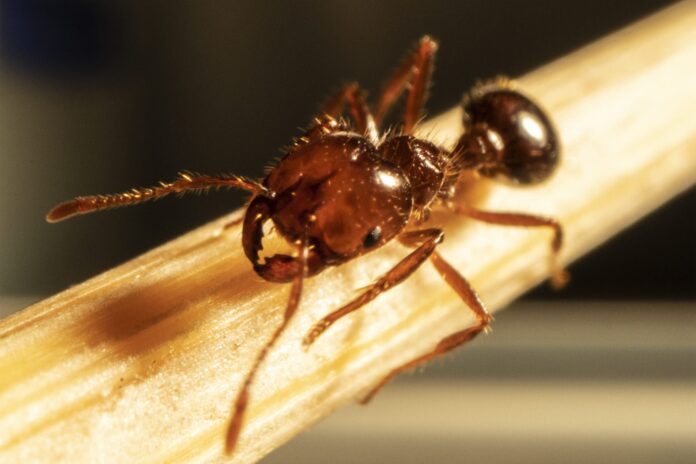Workers trying to eradicate invasive fire ants are being harassed and intimidated as landowners fight back against a mandatory baiting program.
Australia recently ramped up its decades-long effort to stamp out the South American super pest but there’s growing resistance to how it’s being done.
Some property owners are engaged in a lock-the-gates style campaign and don’t want preventative chemical baits spread on their land.
The result has been an increase in physical and psychological harassment and intimidation of treatment teams, both in person and online, the National Fire Ant Eradication Program says.
The program has expressed concerns about a community rally in Brisbane on Saturday, where a critic of the eradication program is due to speak, saying it may put workers at further risk.
Fire ants have been detected at Currimundi, Nirimba and Banya since May, the first time the pests have been discovered on the Sunshine Coast in at least four years.
Authorities have warned Australia stands to lose billions every year if fire ants spread beyond southeast Queensland.
But opponents believe the battle was lost decades ago and the mass distribution of granular bait across the southeast is futile.
Signs are appearing on gates and along fence lines, proclaiming: “We do not consent to the poisoning of us, our properties, pets, livestock, wildlife and eco-systems”.
In response, the eradication program has issued some landholders with notices warning they don’t have the legal right to lock out treatment teams, and obstruction could result in fines of more than $14,000.

It says broadscale treatment across the fire ant zone is essential because ants can be present without any visible signs above ground.
A Facebook forum, titled Stop the Toxic Fireants Program, has more than 2000 followers and features posts urging objectors to confront workers attached to the baiting program.
Some posts name and provide social media links for public servants attached to the program. Others feature footage of residents challenging workers. Some have faced verbal abuse and accusations of trespass.
One post is titled “Wieambilla Can Happen Again” – a reference to the Queensland murders of two police officers and a neighbour by a family of religious extremists.
“Could these government actions cause another Wieambilla? Passionate landowners, wanting to protect their property from poison, could harvest enough hopelessness and negative emotion to lash out in a way that could harm or kill innocent employees of this toxic program,” the post reads.
The Australian Pesticides and Veterinary Medicines Authority has approved the baits that are in use.
It has countered posts about sick and drying animals with assurances that when used as directed, the baits do not pose a significant risk to humans, the environment, or domestic pets.
Subscribe to our FREE daily news feed. All it requires is your name and email at the bottom of this article.
But Trevor Hold, the author of the Wieambilla post, blames the baits for the premature death of two of his calves.
So far, he’s printed 10,000 brochures, and 500 fence signs with “amazing support from concerned residents throughout the eradication zone”.
He stands by that post, saying that as an accredited, qualified counsellor and mental health practitioner he understands the damage “abusive government programs” can have.
Queensland Agriculture Minister Mark Furner says the science is clear and fire ant treatments are effective and safe. He’s referred Mr Hold’s post to authorities.
“This group is spreading misinformation that fire ant bait is a poison – it is not,” he said.
On Saturday, a group called the People’s Revolution will hold a community event in the Brisbane Botanic Gardens.
It is not fire ant-specific but critic, Samford resident and accountant-turned-piano-teacher Sarah McGuire, is among those invited to speak.
She does not condone intimidatory or harassing behaviour but says landholders are feeling harassed too when they are threatened with police intervention and fines.
She wants the program halted until a full environmental impact assessment is done, citing the application of a type of bait that’s harmful to aquatic life over a local creek.
Independent water tests later found it had caused a serious contamination incident, Ms McGuire says.
The Queensland environment department is investigating and the incident sparked changes to the program’s treatment approach.
Do you have an opinion to share? Submit a Letter to the Editor at Sunshine Coast News via news@sunshinecoastnews.com.au. You must include your name and suburb.





